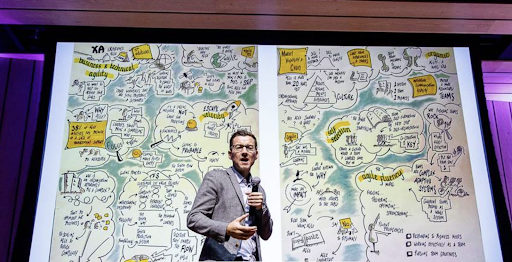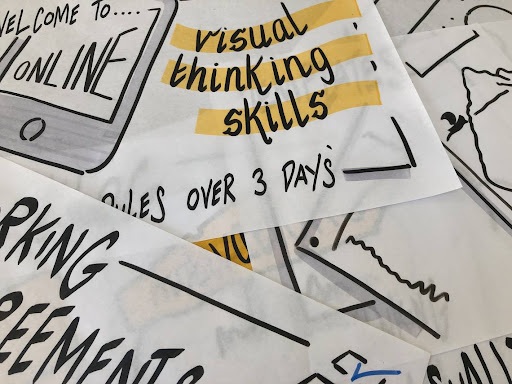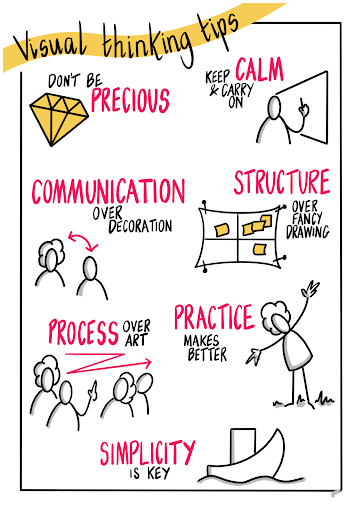Stuart Young on Visual Thinking Strategies for Business

To explore these and other interesting tidbits, we discussed visual thinking strategies with our resident expert in design thinking and visual storytelling, Stuart Young. Stuart is a Certified Scrum Trainer, a business visualizer, and a passionate visual storytelling evangelist.
Why visual thinking?
Roughly 65 percent of people worldwide are visual learners, so they are best able to capture, retain, and use information that’s presented visually. Even those who fall into other learning preferences benefit tremendously from visuals because of the speed and richness of visual information. Consider these facts reported by the Visual Teaching Alliance:
- 90 percent of information transmitted to the brain is visual
- Our brains process visuals 60,000 times faster than text
- 40 percent of nerve fibers are linked to the retina
- Information presented visually improves learning by up to 400 percent
Stuart notes, “While the statistics are startling, what visualization and visual thinking really comes down to is visual literacy. Annelise Tillmann did a great academic study called What We See and Why it Matters in which she said, ‘As children, we are introduced to literature in the form of picture books and learn how to associate the pictures with meaning by navigating the pictures on a page long before we learn to read and write.’ So when we refer to visual thinking we are describing our ability to interpret, comprehend, and express ideas by using or creating visuals.”
“Visualization will simplify complexity, make the intangible tangible, and the invisible visible.”
How does visual thinking fit into today’s business environment?

- The unprecedented rate of change
- The explosion of remote and hybrid work environments
Visualization, used strategically via complementary technology, provides a powerful means of getting complex ideas across quickly so that team members can understand them, apply them, and collaborate accordingly.
“Regardless of industry or the purpose for a facilitated meeting,” Stuart says, “visualization will assist individuals and teams to learn fast, feel more engaged in the learning and retain information more effectively. Visualization provides a higher level of clarity than the written word alone. Visual thinking offers a visual facilitator the opportunity to accelerate learning, engage with the audience, engage with students, and help them to better remember what they have been learning.”
Seven time-tested tips to help you get the most out of visual thinking:
1. Don’t be precious
Your key role is to be a human cursor and capture the salient points of a working group. The pictures you create don’t have to be masterpieces as long as you can catch the essence of live discussions.
2. Keep calm and carry on
Don’t get wrapped up in the fact that you’re standing before a group (or sharing your screen online) to the point that you’re concerned with words that are misspelled or a drawing that doesn’t look quite right. Remember your real goal and remove your ego from the equation.
3. Communication over decoration
You are creating visuals to generate ideas and solve problems while looking to enhance team collaboration and accelerate learning. You are not trying to create a work of art. Don’t embellish your visuals for purely aesthetic reasons.
4. Structure over fancy drawing
Use Templates and visual metaphors as a framework for individuals to embrace diversity of thought before converging on ideas. Encourage spontaneity, freedom, and creativity within a space that is easy to navigate and creates shared understanding.
5. Process over art
Never let the art get in the way of the process it’s meant to facilitate. Creating an information radiator for people to bounce off as they collect their thoughts and walk through a problem is more valuable than the output it creates.
6. Practice makes better
Your grasp of visual thinking and your ability to communicate visually will grow and improve with practice. Don’t expect perfection on day one. At the same time, keep a mental note of what works and what doesn’t in each session so you can continually improve over time.
7. Simplicity is key
When considering how to express a concept or approach a conclusion, always err on the side of simplicity. Pictures are worth a thousand words because they can convey so much meaning at a glance. Don’t hijack that quality by making your pictures more complex than necessary.
Hopefully, these visual thinking strategies have offered your organization a new way of looking at the work you do each day.




